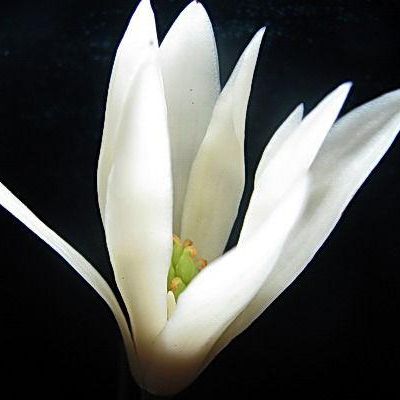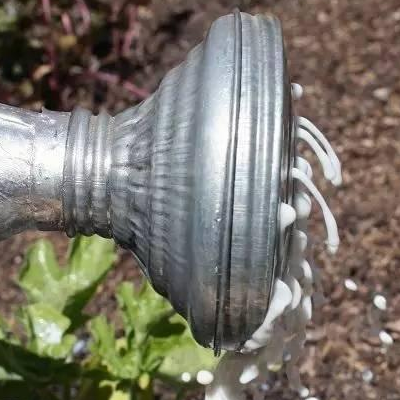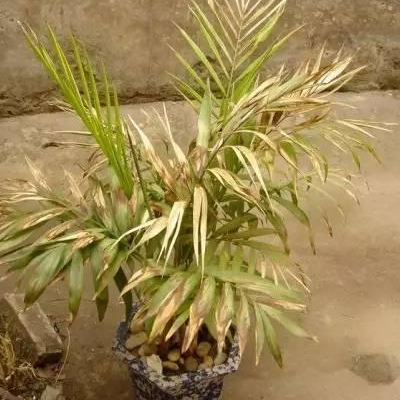What if the leaves turn yellow in the culture of white orchids?
White orchid, the flowering of this plant is more beautiful, the flower is relatively large, how is this white orchid culture method? What if the leaves of the white orchid turn yellow:

Culture methods of white orchids:
(1) because it is neither drought-resistant nor wet-resistant. Therefore, in summer and autumn, because the temperature is higher and evaporates faster, it has a great demand for water, so we should water it in time and keep the soil slightly wet. And its roots are thick and fleshy, and it is most afraid of waterlogging, so the drainage of the basin soil should be unobstructed. Don't get caught in the rain during the rainy season. If we water the topsoil only when it turns white, it will make its basin soil often wet and kill. Therefore, the winter basin soil should be a little dry, not waiting for the inner soil of the tank is also dry, must not be watered.
(2) although it likes fertilizer, we should not fertilize too much. Apart from the fact that we have to fully water the base fertilizer when changing pots every two or three years, we usually only need to water the rotten bean cake or fishy water every 10 days after the plant blossoms.
(3) because it is afraid of the cold and likes the sun, we should ensure that it has at least 10 hours of sunshine every day, even in winter, but also often put outside to bask in the sun.
What if the leaves of the white orchid turn yellow:
1. Watering properly
The amount of water should be continuously adjusted according to the climate wettability and other aspects to ensure the normal and appropriate wettability of the soil.
2. Suitable temperature
In order to avoid excessive temperature difference, it is appropriate to maintain an average temperature of 5-10 ℃. When the temperature increases, special attention should be paid to the ventilation and ventilation of the culture environment and humidification of the dry air.
3. Sufficient light
To ensure sufficient light, you need to put the white orchid in the courtyard or home balcony, windowsill and other places where you can see the light for a long time, but in summer, you should pay attention to avoid the direct light, exposure will also adversely affect the plant.
4. Prevention and treatment of chlorosis
Slightly acidic soil should be selected, a small amount of alkaline inorganic fertilizer should be applied, and when the disease occurs, ferrous sulfate (0.2%) should be sprayed on the leaf surface with a frequency of once a week for 3-4 times, or alum fertilizer and water should be sprayed once a week for 3-4 times to alleviate the disease.
5. Control of root rot.
The occurrence of this disease is usually due to excess water, watering should be "no dry, no watering", and keep the soil loose and enhance its drainage. When there is more rainfall during the Meiyu period, timely rain protection measures should be taken for the plants; more broken tiles can be added at the bottom of the basin to speed up the flow of water and promote drainage.
This is the end of the introduction on the breeding methods of white orchids and the treatment of yellowing leaves, so hurry up to cultivate white orchids.
What if the leaves of white orchids turn yellow? how to deal with the yellow leaves of white orchids?
White orchid belongs to the deciduous tree of Michelia of Magnoliaceae, which is as high as 17mur20 meters. Potted plants are usually 3mur4 meters tall, and there are also small plants. Bark gray, young branches evergreen, leaves oblong, simple leaves alternate, turquoise, leathery glossy, long oval. The flower bud is like the pen head of a brush. There are 8 petals, white as snow, born between leaf axils. The flowers are white or yellowish, the petals are thick, long lanceolate, fragrant, with a long flowering period, and bloom continuously from June to October.
Analysis of yellowing of leaves of White Orchid
In winter, white orchids sometimes appear yellow. In winter, when the white orchid just enters the room, the respiration of the leaves is still relatively strong, if the watering is not timely, the basin soil is dry, the roots and leaves will wither. After the Winter Solstice, the white orchid began to dormancy, watering should be reduced, too much watering will cause leaves yellowing, or even fallen leaves.
Secondly, there are the reasons of light and temperature. In winter, the light is insufficient and the temperature is too low. If the white orchid is in this state for a long time, the white orchid can not photosynthesize well, which will cause the leaves to turn yellow.
We also need to pay attention to the problem of fertilization in winter. Generally speaking, after the white orchid enters the room in winter, there is no need to apply fertilizer, because the plant is dormant, fertilization may cause its rotten roots and leaves to turn yellow.
How to deal with the yellowing of white orchid leaves
Before entering the house in winter, white orchids need to be pruned, cutting off those withered and diseased branches on the plant to avoid withering and even diseases and insect pests.
When breeding indoors, you generally need to meet the following conditions: put the white orchid in a sunny place indoors, and raise the temperature to protect its roots so that it can resume growth in spring. At the same time, we need to stop fertilizing, and do not water too much, keep the basin soil dry, we can safely pass the winter.
If, in the family breeding white orchid, the lack of good conservation conditions, we can use a relatively simple method to make it safe through the winter. The method is to cover the magnolia with a plastic bag and tie it up, and then put the flowerpot in the sunny place, which can also play the role of heat preservation and moisturizing, which is conducive to the white orchid through the winter.
How to reproduce white orchids? what about the yellowing leaves of white orchids?
White orchid is a small and medium-sized potted plant, like a warm and humid environment, and a variety of breeding methods, we need to breed carefully to avoid yellowing leaves. So, how do white orchids reproduce? What if the leaves of white orchids turn yellow? The following will give you a detailed introduction.
How do white orchids reproduce?
Reproduction: White orchids are mainly propagated by grafting, and they can also be propagated by pressing and sowing.
Grafting propagation often uses magnolia seedlings as rootstocks, usually cutting and leaning grafting.
Cutting can use 1-2-year-old purple magnolia as rootstock, in the sunny day of mid-March, after about 20-30 days, the terminal bud can draw leaves. In the south, it can also be carried out before and after the Autumn Equinox, or budding in August to September.
The whole growing season can be carried out from spring to autumn. It is generally carried out more from April to July. The abutment is best at 70 cm from the ground. The rootstock can choose the purple magnolia which is about 0.6cm thick as the rootstock, select the sturdy white orchid branches of the same thickness as the rootstock as the scion, then cut off the skin and part of the xylem of the rootstock and scion by 6cm in length, and the cutting surface should be smooth. Then align the cambium of the two cutting surfaces and close them together, and fasten them with plastic straps to prevent Rain Water from scouring. After about 50 days, the grafting site healed and could be cut off from the mother plant. It is easy to survive by grafting, but it does not grow vigorously as well as cutting.
There are two kinds of striping reproduction: ordinary crimping and college crimping.
The ordinary pressing is usually carried out from February to March, cut the branch to be taken half the depth from the base, then cut a section up, stuck a tile in the middle, and then gently press it into the soil, do not break it, and then use thick wire to fix the branches in the soil to prevent them from tilting up, and then pile them on the soil. After the root bud is sent out, it can be cut off and planted separately.
Air striping is generally in front of people, select robust and disease-free biennial branches, peel them around 55 cm from the top, the width of the ring is about 2.5 cm, and then apply B12 injection to the notch. then use the opposite bamboo tube or tile body to surround the ring peeling place, tie it with a rope, and fix the bamboo tube or tile bowl, adding human culture soil to the bamboo tube or tile bowl. After that, pay attention to often watering the bamboo tube or tile bowl of the pressed branches, so that the internal soil is moist and dry. For a month or so, cut off a small piece of bark on the same branch 5-7 cm below the ring. At the same time, an appropriate amount of 500 times of potassium dihydrogen phosphate aqueous solution was added to the culture soil. After that, it was cut in different directions in the same place every 10 days or so, in order to gradually reduce the nutrient and water relationship between the pressed branch and the mother, so that after cutting for 3 or 4 times, the ring peeling site could heal and form nodules and root buds appeared.
Sowing and reproduction are generally carried out at the end of September or early October, harvest the mature fruit, take out the seeds, soak them in ash water for 1-2 days, then rub the waxy aril by hand, then wash them with water, and then sow the seeds. If the seeds are not sown at this time, the seeds can be refrigerated with the wet sand stratification method and sowed in the indoor pot in March of the following year. If the seeds are not refrigerated, the seeds will easily lose their germination ability. Seedlings can emerge about 20 days after sowing. Sowing substrate should have good air permeability and water permeability, pay attention to keep moist.
What if the leaves of white orchids turn yellow?
First, too much water: White orchid pot soil watering too much or too little, when dry and wet, etc., fleshy root system can not stand, will cause the leaf yellowing phenomenon.
Treatment method: watering should be appropriate, after the basin soil is dry, the amount of water should not be too much at one time, and it should not be watered for a long time because of drought.
Second, lack of light: White orchids like the sun, if the sun is too little, it will also cause poor plant growth and yellow leaves.
Treatment: White orchid is suitable for planting in the courtyard or home balcony, windowsill and other places, need sufficient sunshine, but can not be exposed, the summer sun should pay attention to shade.
Third, the temperature is too high: the yellowing of the leaves of white orchids has a lot to do with the temperature, and the leaves will turn yellow when the temperature is too high and muggy.
Treatment method: the temperature should be kept stable, but high or too low, 5-10 ℃ is the most suitable, the temperature rises, the environment muggy should pay attention to ventilation, and strengthen humidity management.
Fourth, iron deficiency chlorosis: mainly basin soil alkali. The reason why the basin soil is alkaline: first, its own basin soil is alkaline; second, it applies more alkaline inorganic fertilizer or water, so the leaves gradually change from green to yellowish white, and when serious, the leaves are brown, resulting in local necrosis.
Treatment method: slightly acidic soil should be selected for white orchid pot soil, and more alkaline inorganic fertilizer or water should not be applied. Foliar spraying of 0.2% ferrous sulfate should be used in time for chlorosis, once a week, 3 ^-4 times continuously, or alum fertilizer water should be sprayed once a week for 3 or 4 times in a row to control the disease.
Fifth, insufficient fertilization: long-term loss of fertilizer, or long time did not change the basin to change the soil, the lack of nitrogen and other nutrients in the soil, resulting in thin leaves thin and yellow. In addition, excessive fertilization will also lead to the thickening and uneven of new leaves and the shedding of the dry tip of old leaves.
Treatment method: in case of this phenomenon, we should immediately stop fertilization, increase the amount of water, remove part of the old soil, replace the new culture soil, and carry on the normal management.
6. Root rot: excessive watering and failure to remove stagnant water in the basin in time will lead to blackening and decay of roots, yellowing and even shedding of leaves, leading to the death of the whole plant.
Treatment: therefore, usually have to wait until the basin soil surface whitening before watering, and often loosen the soil. When there is too much Mei Yu or Rain Water, it is appropriate to move under the eaves or indoors to take shelter from the rain; when putting on the basin, more broken tiles should be added to the bottom of the basin to smooth drainage and put up the basin bricks to speed up the flow of water.
The above are some answers to how white orchids reproduce and how their leaves turn yellow. Is it clear to all? Please pay attention to more household knowledge.
- Prev

The benefits of raising flowers with milk Control aphid soft pests
Milk, this is a lot of small partners are like, a bottle every day, what are the benefits of this milk flower: milk as fertilizer, milk is a good source of calcium, this principle is also applicable to plants, milk as can be applied to some common vegetable plants
- Next

What are the daily maintenance skills for loose-tailed sunflower leaves to turn yellow and dry?
Loose-tailed sunflower, generally indoor breeding, made of potted, this loose-tailed sunflower leaves yellow dry how to do? What are the daily maintenance skills of loose-tailed sunflower: what about the yellowing and withering leaves of loose-tailed sunflower? this is about the growing environment that loose-tailed sunflower likes. It is a tropical foliage plant and likes a warm and humid environment.
Related
- Fuxing push coffee new agricultural production and marketing class: lack of small-scale processing plants
- Jujube rice field leisure farm deep ploughing Yilan for five years to create a space for organic food and play
- Nongyu Farm-A trial of organic papaya for brave women with advanced technology
- Four points for attention in the prevention and control of diseases and insect pests of edible fungi
- How to add nutrient solution to Edible Fungi
- Is there any good way to control edible fungus mites?
- Open Inoculation Technology of Edible Fungi
- Is there any clever way to use fertilizer for edible fungus in winter?
- What agents are used to kill the pathogens of edible fungi in the mushroom shed?
- Rapid drying of Edible Fungi

